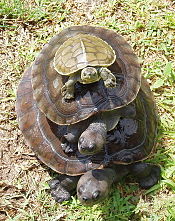Four-eyed turtle
| Four-eyed turtle | |
|---|---|

| |
| Scientific classification | |
| Domain: | Eukaryota |
| Kingdom: | Animalia |
| Phylum: | Chordata |
| Class: | Reptilia |
| Order: | Testudines |
| Suborder: | Cryptodira |
| Superfamily: | Testudinoidea |
| Family: | Geoemydidae |
| Genus: | Sacalia |
| Species: | S. quadriocellata
|
| Binomial name | |
| Sacalia quadriocellata Siebenrock, 1903
| |
| Synonyms[3] | |
| |
The four-eyed turtle
Geographic range
This species of turtle occurs in southern
Hybridization
A male of this species has successfully produced hybrids with the Golden coin turtle in captivity. Given that the "four-eye" pattern is inherited by these hybrids, it seems well possible that the mysterious Chinese false-eyed turtle (Sacalia pseudocellata) is actually based on a hybrid specimen.[6]
Description
The four-eyed turtle can grow to a carapace length of 15 cm (5.9 in). Its carapace typically ranges in color from a yellowish-tan to a deep chocolate-brown, and all turtles have a distinct pattern of lines. The turtle's head is often colorful with yellow or green eyes, yellow stripes, and a pink or red throat. Two (sometimes four) eye-like ocelli occur on the back of the head, hence the turtle's name.[7][verification needed][8]
Ecology
Four-eyed turtles occur in freshwater
. As a result of their rugged surroundings, they have adapted to become adept climbers.While their dietary preferences have not been studied in detail, it is known that they do eat a wide variety of animals and plants including
Status and conservation
The species is listed as
A main factor in the decline of the four-eyed turtle is trade and demand for their shells.[9] Therefore, species recovery programs are needed to ensure the future of the species. There is currently an extensive communication between zoo and conservation personnel in Vietnam whose goal is to coordinate recovery programs. The recovery programs will include legal protection for the turtles which will affect turtle trading.[10][11]
Large quantities of turtle shell are used as an ingredient in
Conservation efforts
The Asian Turtle Program has helped publicize turtle conservation all throughout Asia.[13] The ATP, a branch of Indo-Myanmar Conservation, has a regularly updated website with up-to-date news that helps spotlight the status of endangered turtles throughout Asia.
References
- . Retrieved 19 November 2021.
- ^ a b "Appendices | CITES". cites.org. Retrieved 2022-01-14.
- ISSN 1864-5755. Archived from the original(PDF) on 2011-05-01. Retrieved 29 May 2012.
- ^ Sometimes confused with a related and similar species, Beale's four-eyed turtle (Sacalia bealei ).
- ^ a b c "Sacalia quadriocellata". Asian Turtle Conservation Network. Archived from the original on 2007-08-25. Retrieved 2007-05-08.
- ^ Parham et al. (2001), Buskirk et al. (2005).
- ^ "Sacalia bealei : Four-eyed turtle". The Asian Turtle Consortium. Archived from the original on 2007-06-10. Retrieved 2007-05-15.
- ^ "Chinese Four-Eyed Turtles, genus Sacalia". Hopson, Mary. Retrieved 2007-05-09.
- ^ Gray, Jordan (June 2017). "Species Spotlight Vol. 6". Turtle Survival Alliance. Archived from the original on 2018-07-19.
- ^ "Turtle Adoption Package - for the Turtle Conservation Centre (TCC), Vietnam" (PDF). Asian Turtle Program. Archived from the original (PDF) on 2013-01-27.
- ^ "Turtle Survival Alliance" (PDF). Turtle Survival org. Archived from the original (PDF) on 2013-01-27.
- ^ "Conclusions from the Workshop on Trade in Tortoises and Freshwater Turtles in Asia". Asian Turtle Trade Working Group. Retrieved 2007-05-19.
- ^ "Asian Turtle Conservation Network". Archived from the original on 2007-05-29. Retrieved 2007-05-19.
- Parham, James Ford; Simison, W. Brian; Kozak, Kenneth H.; Feldman, Chris R. & Shi, Haitao (2001). New Chinese turtles: endangered or invalid? A reassessment of two species using mitochondrial DNA, allozyme electrophoresis and known-locality specimens. Animal Conservation 4 (4): 357–367. HTML abstract Erratum: Animal Conservation 5 (1): 86 HTML abstract
- Siebenrock, Friedrich. (1903). "Schildkröten des östlichen Hinterindien". Sitzungsberichte der Mathematisch-Naturwissenschaftlichen Klasse der Kaiserlichen Akademie der Wissenschaften [Vienna] 112: 333-353. ("Clemmys bealii Gray nov. var. quadriocellata", pp. 336–338).


